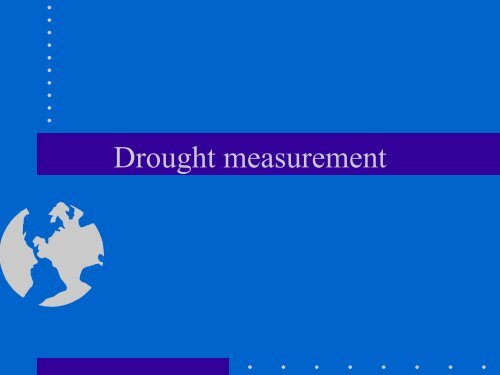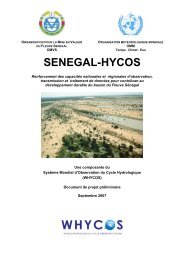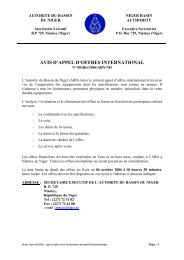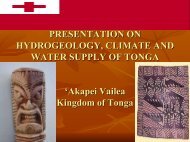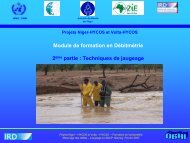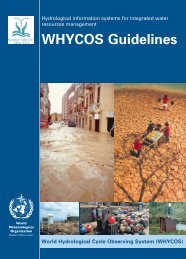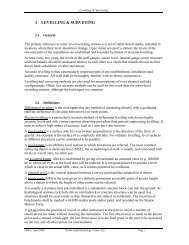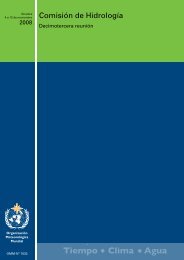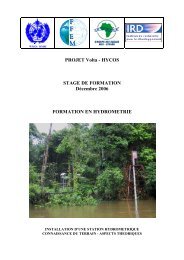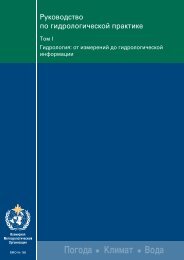Using response function concepts to model groundwater ... - WHYCOS
Using response function concepts to model groundwater ... - WHYCOS
Using response function concepts to model groundwater ... - WHYCOS
You also want an ePaper? Increase the reach of your titles
YUMPU automatically turns print PDFs into web optimized ePapers that Google loves.
Drought measurement
Overview<br />
• Definitions of drought<br />
• Raro<strong>to</strong>nga case study<br />
• Practical exercise – Excel example<br />
– Rainfall depreciation method (weighted sum)<br />
– Decile method
Reactions <strong>to</strong> the 1997-98 El Nino<br />
• Water supply reliability severely tested<br />
– Kiribati - impact on <strong>groundwater</strong> lens<br />
– Marshall Is - interest in desalination<br />
– Fiji Is - Suva water supply, Drought Emergency<br />
– Cook Islands - need for demand management<br />
• Questions<br />
– How long is the current drought going <strong>to</strong> last<br />
– How severe is it What can be done<br />
– How frequently can droughts be expected
Drought as a Natural Hazard<br />
• Loss of life<br />
• health problems<br />
• increased risk of fire<br />
• deterioration of water quality<br />
• loss of agricultural production<br />
• increased demand for water<br />
• salt water intrusion
Drought Definitions<br />
• Partial or <strong>to</strong>tal absence of rainfall or<br />
irregular distribution during a period in<br />
which precipitation should occur<br />
• prolonged or abnormal moisture deficiency<br />
• “a worrisome lack of rain”<br />
• Meteorological, Agricultural, Hydrological,<br />
Socioeconomic
The Climate / Drought Linkage<br />
Climatic State<br />
Precipitation Anomaly<br />
Water Resources Anomaly<br />
(low stream flows, <strong>groundwater</strong> and soil moisture<br />
levels)<br />
Drought Effects<br />
(loss of production, health problems, etc.)
Measuring Drought<br />
• Climate data based<br />
– Palmer Drought Index (PDI)<br />
– Standardized Precipitation Index (SPI)<br />
– Decile (percentile ranking)<br />
– Rainfall depreciation<br />
• Effects based<br />
– Remote sensing<br />
– Socioeconomic survey of impacts
Reducing Drought Consequences<br />
• Coping e.g.<br />
– leak detection & control<br />
– water conservation campaigns<br />
– emergency water supplies<br />
• Adaptation e.g.<br />
– changes in farming patterns<br />
– drought <strong>to</strong>lerant species<br />
– irrigation<br />
– drought management plans
Case study
Raro<strong>to</strong>nga, Cook Islands<br />
• Reticulated water supply dependent on<br />
several small catchments<br />
• No effective s<strong>to</strong>rage<br />
• Limited control on water use from<br />
reticulated supply<br />
• Need for demand management and leak<br />
control
Raro<strong>to</strong>nga Water Supply - Overview<br />
• 12 Water intakes sited within small<br />
catcment areas<br />
• 4 Underground horizontal water galleries<br />
• 120km pipeline network<br />
• Limited s<strong>to</strong>rage<br />
• Untapped <strong>groundwater</strong>
Raro<strong>to</strong>nga water supply<br />
Very low water flow<br />
in stream/high flow losses<br />
in pipeline network
Impact of recent drought on<br />
Raro<strong>to</strong>nga water supply<br />
Instream filterbeds dry
Impact of drought on Raro<strong>to</strong>nga<br />
water supply<br />
Stream flow diverted<br />
in<strong>to</strong> intake by-pass<br />
line
Raro<strong>to</strong>nga Water Supply<br />
May 98 July 98
Raro<strong>to</strong>nga Water Supply<br />
Water Supply Management requires<br />
methods for:<br />
– Early warning of drought events<br />
– Prediction of severity and duration<br />
– Prediction of future drought events<br />
– Drought severity/duration/frequency<br />
To manage drought we need <strong>to</strong> measure it
Weighted Sum Index<br />
Uses a time window with increasing weight<br />
given <strong>to</strong> most recent rain (a measure of<br />
catchment memory)<br />
Weighted Sum Index<br />
2000<br />
1800<br />
1600<br />
1400<br />
1200<br />
1000<br />
800<br />
600<br />
400<br />
200<br />
0<br />
30 35 40 45 50 55 60 65 70 75 80 85 90 95<br />
Year
Drought Forecast<br />
Long term rainfall forecast allows a forecast<br />
of drought persistence<br />
Weighted Sum Index<br />
1400<br />
1200<br />
1000<br />
800<br />
600<br />
400<br />
Monthly Rainfall (mm)<br />
300<br />
250<br />
200<br />
150<br />
100<br />
50<br />
0<br />
97.03 97.08 98.01 98.06 98.11<br />
Date
Raro<strong>to</strong>nga Management Options<br />
• Public information <strong>to</strong> increase public and<br />
political awareness<br />
• Control of irrigation watering from the<br />
reticulated supply<br />
• Bans on specified classes of water use<br />
during severe or extreme droughts
Information Needs<br />
• need for information <strong>to</strong> allow <strong>response</strong> <strong>to</strong> a<br />
particular drought<br />
• need for information on viable strategies for<br />
coping with drought<br />
• need information on the nature of the<br />
drought hazard -<br />
severity/duration/frequency
Practical exercise<br />
• Use Suva or Nadi monthly time series data<br />
<strong>to</strong> calculate drought indices:<br />
– Deciles<br />
• PERCENTRANK <strong>function</strong><br />
– Rainfall depreciation method<br />
• Index = 0.9*R 0 +0.8*R 0 +0.7*R 0 +0.6*R 0 etc.


